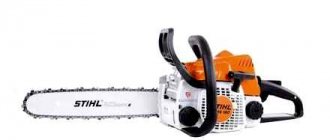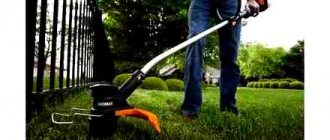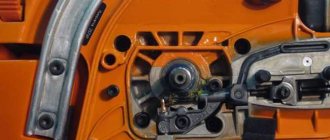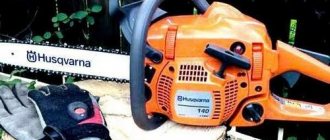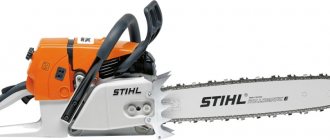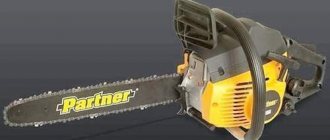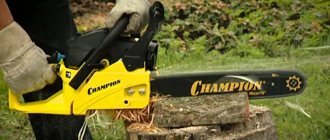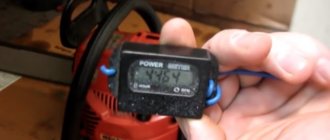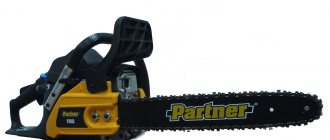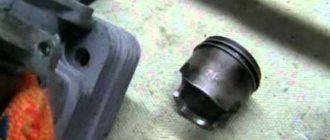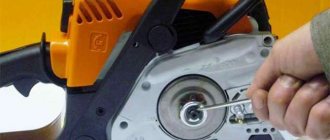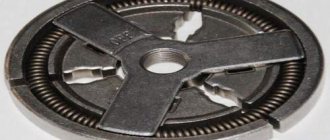Why does the chainsaw not develop speed?
There may be several reasons for the lack of traction and poor speed of the chainsaw. Therefore, you should not immediately start disassembling and repairing the carburetor, since the reason may not be hidden in it.
The Shtil MS 180 chainsaw is equipped with a reliable carburetor, on which the manufacturer has limited the ability to adjust the power and maximum engine speed, so if the chainsaw loses traction, the carburetor is the last place to look for problems.
Muffler
You may ask, which is the first? The answer is a muffler. The muffler is responsible for exhaust gases and extinguishing the flames in them. All combustion products pass through it, which can clog it over time. The situation with a muffler clogged with soot is far from uncommon, and it occurs due to an incorrect fuel mixture.
With a normal ratio of gasoline to oil, combustion products are not so saturated with soot that they clog the muffler. If the amount of oil is more than normal, excessive carbon deposits will form during its combustion. Further, carbon deposits accumulate under the piston rings and in the muffler of the Stihl 180 chainsaw. Thus, a coked muffler is the most harmless thing that can happen, the maximum damage from excessive carbon deposits is the need to replace the piston.
How to check the muffler
To check the muffler, it must be removed from the chainsaw. To do this, using an 8 mm socket, unscrew the two fastening nuts and remove the part.
Important: after the muffler is removed, it is necessary to check the integrity of the gaskets between it and the cylinder, since very often they stick and break when the muffler is removed.
You can clean the part mechanically, using screwdrivers or a knitting needle, and then blow it thoroughly with compressed air. The seat on the muffler can be cleaned with sandpaper to remove burnt parts of the gasket.
The muffler must be installed in the reverse order.
Important: when tightening the muffler mounting nuts, do not over-tighten the nuts, as the threads on the screws can be stripped.
The second reason why a calm chainsaw engine may reduce power and not develop speed is a blockage in the fuel system. As a rule, the first place to start looking for a blockage is the fuel filter.
Checking the fuel filter
The fuel filter is installed in the tank of the Shtil 180 chainsaw, and it is not very convenient to remove it. To make the process easier, you can take a small piece of aluminum wire and bend it at the end, then use it to hook the fuel hose and remove it, along with the filter, from the tank. To check the filter, you need to blow into it; if air does not pass through, then the cause has been found, and the filter needs to be replaced.
If the filter is clean, you need to check the fuel hose for clogging. To check, you need to disconnect it from the carburetor and, with the air filter removed, blow into it. If a blockage is detected, you can clean the hose mechanically, using a wire, and then blow it out with compressed air.
Strainer in carburetor
The last likely place for a blockage to form is the strainer in the carburetor. In the diagram below, it is indicated by the number 13.
In order to clean the mesh filter, you need to remove the carburetor from the Shtil 180 chainsaw. The work begins by removing the top cover of the saw, after which, using an 8 mm socket, unscrewing the two fastening nuts. Next, the filter housing is removed from the guides, after which the air damper rod and the engine control lever are disconnected. Lastly, the fuel hose and throttle linkage are disconnected, after which the carburetor can be removed from the guides.
The carburetor strainer is installed in the fuel pump chamber; in order to get to it, one screw securing the pump cover is unscrewed and it, along with the gaskets, is removed.
The mesh filter can only be cleaned using compressed air. Any mechanical methods are strictly prohibited, since the mesh is very soft and easily changes shape. When you press it, it easily wrinkles and bends form along the edge of the seat, through which unfiltered fuel can enter the carburetor.
During the cleaning process, the seat with the filter installed in it must be half covered with your finger and only then blow with air, otherwise the mesh may fly away and it will no longer be possible to find it.
Carburetor depressurization and nozzle blockage
Sometimes, when the screws securing the carburetor cover are loose or the gaskets have become unusable, the chainsaw may also experience a loss of power. To eliminate the possibility of this malfunction, it is necessary to check the integrity of the gaskets and the tightness of the screws on the carburetor covers. To do this, you need to remove it from the engine (the algorithm is described above) and disassemble it. Defective gaskets must be replaced using spare ones from the repair kit for the Shtil MS 180 carburetor.
In the case where a complete check of the fuel supply and exhaust gas system has been carried out, but there are no results. The main fuel injector valve needs to be checked. To check, you need to knock it out of the carburetor body. All work should proceed according to the following algorithm:
- The carburetor is removed from the chainsaw.
- The four screws securing the cover with the compensator are unscrewed, after which the cover can be removed.
- The carburetor is installed on a wooden lining, after which, using a bolt with a diameter of no more than eight millimeters and a length of 50, it is knocked out into the internal cavity of the carburetor.
- Next, you need to select a small hose, the inner diameter of which matches or is slightly smaller than the outer diameter of the nozzle and put it on the nozzle.
- The next step is to blow inside the hose. If it only blows in one direction, the nozzle is working properly; if it blows in both directions or does not blow at all, then the valve needs to be replaced.
All of the above actions should help in eliminating the problem associated with the fact that the chainsaw does not pick up speed, otherwise, a full diagnosis at the manufacturer’s service center will help.
Characteristics and possible causes of failure. Fixing the problem yourself
Chainsaws are quite reliable and lightweight in design. Therefore, if you properly care for them and treat them based on the manufacturer’s advice, then they fail very periodically and various types of breakdowns are quickly eliminated. But if you are facing this situation and want to repair your own instrument yourself without taking help from experts, then let’s dive into the information provided below.
In fact, it is impossible to clearly and accurately determine the reason why the tool does not start or it stops when you press the gas, because there are quite a lot of reasons for this. But we should not forget that, since the chainsaw is equipped with a conventional two-stroke engine, conditions such as lubricants, fuel, sparks and air are important for its efficient operation.
Chainsaw fuel tank
It follows that the carburetor is specially engaged in making the consistency of the fuel and air filter, the filter removes dust from the air, the ignition unit and spark plug make the spark, and gasoline contains the lubricant.
That is why it is necessary to look for the circumstances of such a disorder one by one, starting from the mild ones and gradually moving to the complex ones. And this is a fundamental factor in proper repair, because a person who, without thinking, begins to analyze a carburetor, is putting it at risk. Because this kind of
unit must be repaired or adjusted directly in special workshops (Read about carburetor adjustment).
- It is important that for trouble-free operation of the tool you need to be quite careful with the fuel itself . Because if this mixture is not prepared correctly, most chainsaws simply will not start. Therefore, every owner will guess to look for the cause of fuel failure. That is why, in order for your tool to always work correctly, you need to use only high-quality gasoline for the mixture.
READ Cut a 45 degree angle on a plastic corner
Why does the chainsaw not slow down?
There may be several reasons why a chainsaw does not slow down:
- throttle spring broken;
- jamming of the gas trigger;
- the throttle linkage is bent;
- The corkscrew of the throttle shaft is lost, causing it to jam.
It is not difficult to solve all these problems; you need to conduct a careful inspection and accurately determine the cause, and then replace the faulty part. As a rule, if the chainsaw picks up speed well, idles and has normal power, then the problem with the fact that it does not slow down is purely mechanical. And finding and eliminating a mechanical fault is much easier than identifying and stopping air leaks in the chainsaw crankcase.
Conclusion
If the first signs of loss of power (reduction in speed) appear with the Shtil MS 180 chainsaw, under no circumstances should you continue to work, but you should immediately contact a specialist or carry out diagnostics and fix the malfunction yourself. There are not many reasons for power loss and you can cope with them even without certain skills. The main thing is to calmly analyze the behavior of the saw and find out the reasons why it stopped pulling (the speed dropped), and eliminating the malfunction is not a difficult task.
What to do
The power tool is operated according to the manufacturer's instructions. Only after checking the chain tension does the unit start. At the same time, the filling of the tanks with combustible mixture and oil is controlled, and the device is securely fixed in the hands. If, after following all the rules, the mechanism refuses to work, then the Shtil chainsaw is repaired.
How to start a Shtil chainsaw correctly: instructions
The tool manufacturer has taken every precaution and developed a manual that makes it easy to start the mechanism. The user will protect himself from injury if he follows the suggested frequency of actions:
- The ignition is turned on and the engine handle is placed in the down position. The flow of atmosphere from the air filter is blocked by the carburetor damper. To properly start a chainsaw, the throttle membrane must be open to enrich the combustible mixture.
- The lever is set to the start gas position. The starter jerks several times before the first spark appears. If the flash passes, the instrument is ready to start. The mechanism operates at high speeds due to the closed throttle membrane. To transfer it to the idle speed regulation, the throttle trigger is pressed and immediately released. The number of revolutions quickly returns to normal.
- The standard Shtil MS unit does not provide additional devices to start the chainsaw in the lightweight version.
Idle speed adjustment
Before setting up, carry out maintenance of the tool. To ensure that the idle speed adjustment is effective, preventive measures are taken:
- carburetor cleaning;
- engine flushing;
- cleaning the air filter;
- warming up the engine.
To adjust the operation of the mechanism at idle speed, use the appropriate adjusting screw. Its rotation depends on the required setting:
- During standard adjustment, the screw is turned counterclockwise until it turns tightly. After this, make 2 circles in the direction of the arrow.
- If the saw operates at low speeds, then turn the screw clockwise until the chain begins to move. Then make half a circle in the opposite direction.
- At high frequencies, the regulator is turned counterclockwise until the circuit stops. After this, the rotation is continued another half turn in the same direction.
It will not be possible to adjust the idle speed if there is air leakage into the engine through the gasket, acceleration pump, seals, or for another reason.
Ignition settings
Gasoline engines are equipped with an ignition system that ignites the fuel. The timing of the flash affects the operation of the motor. During mass production in factory conditions, the ignition of the chainsaw is not adjusted. Marks are placed on the corresponding rotating elements, which are aligned during adjustment. Incorrect adjustment leads to the mechanism starting and stalling.
Before adjustment, check the dryness of the spark plug and the functionality of the ignition circuit. The voltage supply cable to the spark plug is brought to the cylinder with a small gap and the starter is started. If there is no flash, test the cable with a probe. Then check the serviceability of the wire to the shutdown button.
If the cables are not damaged, then check the ignition coil. This is done with a special tester to ring the device. In this case, the indicators on the device must coincide with the technical characteristics of the coil, which are specified in the instructions for use. If inconsistencies are detected, the ignition unit is replaced with a functional device.
The reel can become unusable due to vibration when the tool is dropped or hit, so you need to work carefully.
Replacing crankshaft bearings
First, they measure the compression; if it is not there, then the reason lies in the breakdown of the piston group.
The required pressure in the cylinder should be 8 atm; if it is lower, then the cylinder and piston, rings, and crankshaft bearings may have worn out.
To find out the condition of the piston system, you need to completely disassemble the saw and remove all the main components of the mechanism:
- dismantle the headset, remove the cover on the bus;
- remove the tire guide and tool chain using the wrench included in the kit;
- remove the air filter, remove the spark plug;
- a piston stopper is attached in place of the spark plug to secure the crankshaft;
- remove the clutch, then access to the clutch system is opened.
Rings with bearings are inspected and defects are identified. You can replace it yourself, which will require repair skills, or you can take the tool to a specialized workshop. Assembly is done in reverse order.
